A Multiphysics Model for the Near-Field Evolution of a Geological Repository of Radioactive Waste
Abstract
:1. Introduction
1.1. Deep Geological Disposal Concept
1.2. Multibarrier System
- The first barrier is the nuclear fuel pellets, which is durable and temperature resistant, and has a low dissolution potential.
- The second barrier is the fuel elements and fuel bundles. A bundle consists of several sealed tubes called elements, into which fuel pellets are inserted. The fuel elements are made of corrosion-resistant zircaloy.
- The third barrier is the spent fuel containers (UFCs), which are designed to withstand anticipated loads and corrosion.
- The fourth barrier, called a buffer, is a compact bentonite sealing system that encapsulates the UFCs in the emplacement room. The primary roles of this barrier are to reduce water flow around the UFCs to limit corrosion processes and microbial activities. Also, the buffer protects the UFCs by mitigating mechanical damage from seismic events and small-scale fault movement. The buffer, due to its low permeability and high sorption capacity would also constitute an additional barrier to radionuclides migration, should they be released from the UFCs in the future.
- The outermost barrier is the natural rock formation that will protect the DGR from natural events and human intrusion. Also, it provides a barrier to potential radionuclide migration to the near surface.
2. Conceptualization and Mathematical Model of Multiphysical Processes in the near Field of a DGR
2.1. Conceptual Model
2.2. Mathematical Model
- The geological medium is conceptualized as a porous medium.
- Only heat is considered in the energy balance equation. Thermal equilibrium is assumed between the solid and liquid phases. Furthermore, heat convection may be neglected, and heat transfer occurs only by conduction [19].
- The porewater can exist either in a liquid or gaseous (vapour) state. The flow of liquid water is driven by advection and is assumed to follow Darcy’s law, while the vapour flow is driven by diffusion.
- A modified Biot’s effective stress principle is assumed:
2.2.1. Equation of Heat Conservation
2.2.2. Equation of Momentum Conservation (Quasi-Static Equilibrium)
2.2.3. Equation of Mass Conservation
- The first term of the equation results from the adoption of Darcy’s law for pore fluid flow in unsaturated porous media.
- The second term represents vapour flow due to thermal gradients and pressure gradients.
- The third term denotes water retention due to the unsaturated state of the medium. In this term, w is the gravimetric water content and is the specific gravity of the soil particles. When the medium is fully saturated, w is independent of p, and this term becomes zero.
- The fourth term implies water retention due to compressibility of the water and solid phase.
- The fifth term represents water retention due to the consolidation of the porous medium.
- The sixth term represents water flow due to difference in thermal expansion between the water and solid material.
2.2.4. Equation of Solute Transport
3. Verification
3.1. The 1D Consolidation of Soil Column
3.2. Thermal Consolidation around a Point Heat Source
4. Validation against Sand/Bentonite Column Experiment
4.1. Experimental Set-Up
4.2. Modelling Approach
4.2.1. Soil Water Characteristic Curve (SWCC) and Relative Permeability (kr)
4.2.2. Thermal Conductivity and Specific Heat Capacity
4.2.3. Theory of Vapour Transport in Porous Media
| Parameter | Value | Unit |
|---|---|---|
| Porosity (n) | 0.463 | - |
| Compressibility of fluid (χf) | 4 × 10−10 | 1/Pa |
| Compressibility of solid (χp) | 1 × 10−8 | 1/Pa |
| Density of water | 1000 | kg/m3 |
| Initial negative pore pressure (suction) | −1.08 × 108 | Pa |
| Tortuosity factor | 0.5 | - |
| Molecular weight of water | 18 × 10−3 | kg/mol |
| Ideal gas constant | 8.314 | J/mol/K |
| Gas constant for vapour | 461.5 | J/kg/K |
| Thermal diffusivity enhanced factor | 4 [43] | - |
| Brook and Corey parameters: | ||
| α | 8.92 × 10−3 | mH2O−1 |
| n | 0.55 | - |
| l | −1.37 | - |
| Saturated permeability (kij) | 1 × 10−19 | m2 |
4.3. Results
5. Scoping Analysis of THM-Solute Transport Coupling
6. Conclusions
Author Contributions
Funding
Data Availability Statement
Acknowledgments
Conflicts of Interest
References
- NWMO. Deep Geological Repository Conceptual Design Report Crystalline/Sedimentary Rock Environment. NWMO Report APM-REP-00440-0015 R001. 2016. Available online: https://www.nwmo.ca/en/Reports (accessed on 1 May 2023).
- Nuclear Waste Management Organization (NWMO). Confidence in Safety—South Bruce Site; Report NWMO-TR-2022-12; Nuclear Waste Management Organization (NWMO): Toronto, ON, Canada, 2022. [Google Scholar]
- Nguyen, T.S. Thermo-Hydro-Mechanical-Chemical processes in geological disposal of radioactive waste—An example of reg-ulatory research. Adv. Geo-Energy Res. 2018, 2, 173–189. [Google Scholar] [CrossRef]
- Chijimatsu, M.; Fujita, T.; Sugita, Y.; Taniguchi, W. Evaluation of Couple Thermohydro-Mechanical Phenomena in the Near Field for Geological Disposal of High-Level Radioactive Waste. No. JNC-TN-8400-2000-008. Japan Nuclear Cycle Development Institute. 2000. Available online: https://inis.iaea.org/search/search.aspx?orig_q=RN:31062628 (accessed on 1 May 2023).
- Nguyen, T.S.; Selvadurai, A.P.S. Coupled thermal-hydraulic- mechanical processes in a cylindrical cavity in rock. In NUMOG VI: Proceedings of the International Symposium on Numerical Models in Geomechanics, Montreal, QC, Canada, 2–4 July 1997; Pande, G.N., Pietruszczak, S., Eds.; A.A. Balkema: Leiden, The Netherlands, 1997; pp. 315–324. [Google Scholar]
- Pintado, X.; Autio, J.; Punkkinen, O. On the behaviour of compacted bentonite under thermal gradients. Phys. Chem. Earth 2011, 36, 1799–1805. [Google Scholar] [CrossRef]
- Schanz, T.; Long, N.T.; Datcheva, M. A Column experiment to study the thermo-hydro-mechanical behaviour of expansive soils. Rock Mech. Rock Eng. 2013, 46, 1287–1301. [Google Scholar] [CrossRef]
- Selvadurai, A. Heat-induced moisture movement in a clay barrier: 2. Computational modelling and comparison with experimental results. Eng. Geol. 1996, 41, 219–238. [Google Scholar] [CrossRef]
- Gens, A.; Sánchez, M.; Guimarães, L.D.N.; Alonso, E.E.; Lloret, A.; Olivella, S.; Villar, M.V.; Huertas, F. A full-scale in situ heating test for high-level nuclear waste disposal: Observations, analysis and interpretation. Géotechnique 2009, 59, 377–399. [Google Scholar] [CrossRef]
- Villar, M.; Lloret, A. Influence of temperature on the hydro-mechanical behaviour of a compacted bentonite. Appl. Clay Sci. 2004, 26, 337–350. [Google Scholar] [CrossRef]
- Fall, M.; Nasir, O.; Nguyen, T. A coupled hydro-mechanical model for simulation of gas migration in host sedimentary rocks for nuclear waste repositories. Eng. Geol. 2014, 176, 24–44. [Google Scholar] [CrossRef]
- Nasir, O.; Fall, M.; Nguyen, T.; Evgin, E. Modelling of the hydro-mechanical response of sedimentary rocks of Southern Ontario to past glaciations. Eng. Geol. 2011, 123, 271–287. [Google Scholar] [CrossRef]
- Nasir, O.; Fall, M.; Nguyen, T.S.; Evgin, E. Modeling of the thermo-hydro-mechanical-chemical response of Ontario sedimentary rocks to future glaciations. Can. Geotech. J. 2015, 52, 836–850. [Google Scholar] [CrossRef]
- Abdi, H. Mechanical and Hydromechanical Behavior of Host Sedimentary Rocks for Deep Geological Repository for Nuclear Wastes. Ph.D. Thesis, University of Ottawa, Ottawa, ON, Canada, 2014. [Google Scholar]
- Nguyen, T.S. Computational Modelling of Thermal-Hydological-Mechanical Processes in Geological Media. Ph.D. Thesis, McGill University, Montreal, QC, Canada, 1995. [Google Scholar]
- Nguyen, T.S.; Li, Z.; Garitte, B.; Barnichon, J.D. Modelling a heater experiment for radioactive waste disposal. Environ. Geotech. 2019, 6, 87–100. [Google Scholar] [CrossRef]
- Dagher, E.E.; Nguyen, T.S.; Sedano, J.A.I. Development of a mathematical model for gas migration (two-phase flow) in natural and engineered barriers for radioactive waste disposal. Geol. Soc. Lond. Spéc. Publ. 2018, 482, 115–148. [Google Scholar] [CrossRef]
- Li, Z.; Su, G.; Zheng, Q.; Nguyen, T.S. A dual-porosity model for the study of chemical effects on the swelling behaviour of MX-80 bentonite. Acta Geotech. 2020, 15, 635–653. [Google Scholar] [CrossRef]
- Gens, A.; Vaunat, J.; Garitte, B.; Wileveau, Y. In situ behaviour of a stiff layered clay subject to thermal loading: Observations and interpretation. Géotechnique 2007, 57, 207–228. [Google Scholar] [CrossRef]
- Nguyen, T.; Selvadurai, A.; Armand, G. Modelling the FEBEX THM experiment using a state surface approach. Int. J. Rock Mech. Min. Sci. 2005, 42, 639–651. [Google Scholar] [CrossRef]
- Nguyen, T.S.; Li, Z.; Le, D.A. Constitutive model development and field simulation of excavation damage in bedded argillaceous rock. Eur. J. Environ. Civ. Eng. 2020, 27, 2850–2871. [Google Scholar] [CrossRef]
- van Genuchten, M.T. A closed-form equation for predicting the hydraulic conductivity of unsaturated soils. Soil Sci. Soc. Am. J. 1980, 44, 892–898. [Google Scholar] [CrossRef]
- Brooks, R.H.; Corey, A.T. Properties of Porous Media Affecting Fluid Flow. J. Irrig. Drain. Div. 1996, 92, 61–90. [Google Scholar] [CrossRef]
- Terzaghi, K. Die Berechnung der Durchlassigkeitsziffer des Tones aus Dem Verlauf der Hidrodynamichen Spannungs-er-scheinungen Akademie der Wissenschaften in Wien. Math.-Naturwissen-Schaftliche Kl. Sitzungsberichte Ab-Teil. IIa 1923, 132, 125–138. [Google Scholar]
- Booker, J.R.; Savvidou, C. Consolidation around a point heat source. Int. J. Numer. Anal. Methods Géoméch. 1985, 9, 173–184. [Google Scholar] [CrossRef]
- Zheng, X.; Pisano, F.; Vardon, P.J.; Hicks, M.A. An explicit stabilized material point method for coupled hydromechanical problems in two-phase porous media. Comput. Geotech. 2021, 135, 104–112. [Google Scholar] [CrossRef]
- Jeremić, B.; Cheng, Z.; Taiebat, M.; Dafalias, Y. Numerical simulation of fully saturated porous materials. Int. J. Numer. Anal. Methods Géoméch. 2008, 32, 1635–1660. [Google Scholar] [CrossRef]
- Bandara, S.; Soga, K. Coupling of soil deformation and pore fluid flow using material point method. Comput. Geotech. 2014, 63, 199–214. [Google Scholar] [CrossRef]
- Das, B.M.; Sivakugan, N. Fundamentals of Geotechnical Engineering, 5th ed.; Cengage Learning: Boston, MA, USA, 2017. [Google Scholar]
- Booker, J.; Savvidou, C. Consolidation around a spherical heat source. Int. J. Solids Struct. 1984, 20, 1079–1090. [Google Scholar] [CrossRef]
- Nguyen, T.S.; Selvadurai, A.P.S. Modelling of thermal consolidation of sparsely fractured rock in the context of nuclear waste management. In Mechanics of Poroelastic Media; Selvadurai, A.P.S., Ed.; Kluwer Academic Publisher: Dordrecht, The Netherlands, 1996; Volume 35, pp. 159–180. [Google Scholar]
- Chaudhry, A.A.; Buchwald, J.; Kolditz, O.; Nagel, T. Consolidation around a point heat source (correction and verification). Int. J. Numer. Anal. Methods Géoméch. 2019, 43, 2743–2751. [Google Scholar] [CrossRef]
- Gaus, I.; Wieczorek, K.; Mayor, J.C.; Trick, T.; García-Siñeriz, J.L.; Schuster, K.; Garitte, B.; Kuhlman, U. EBS behaviour immediately after repository closure in a clay host rock: The HE-E experiment (Mont Terri URL). In Proceedings of the 14th International Conference on Environmental Remediation and Radioactive Waste Management (ICEM’11), Reims, France, 25–29 September 2011. [Google Scholar]
- Ballarini, E.; Graupner, B.; Bauer, S. Thermal–hydraulic–mechanical behaviour of bentonite and sand-bentonite materials as sealfor a nuclear waste repository: Numerical simulation of column experiments. Appl. Clay Sci. 2017, 135, 289–299. [Google Scholar] [CrossRef]
- Villar, M.V.; Martín, P.L.; Romero, F.J. Long-Term THM Tests Reports: THM Cells for the HE-E Test: Update of Results until February 2014. CIEMAT Technical Report CIEMAT/DMA/2G210/03/2014. 2014. Available online: https://cordis.europa.eu/docs/projects/files/249/249681/long-term-thm-tests-reports-thm-cells-for-the-he-e-test-update-of-results-until-february-2014.pdf (accessed on 1 May 2023).
- Gaus, I.; Garitte, B.; Senger, R.; Gens, A.; Vasconcelos, R.; Garcia-Sineriz, J.-L.; Trick, T.; Wieczorek, K.; Czaikowski, O.; Schuster, K.; et al. Long-term Performance of Engineered Barrier Systems PEBS: The HE-E Experiment: Lay-out, Interpretation and THM Modelling. Narga Arbeitsbericht NAB 14-53. Nagra, Wettingen. 2014. Available online: https://www.pebs-eu.de/PEBS/EN/Downloads/D2_2_1_1.pdf?__blob=publicationFile&v=1 (accessed on 1 July 2023).
- Gaus, I.; Wieczorek, K.; Schuster, K.; Garitte, B.; Senger, R.; Vasconcelos, R.; Mayor, J.C. EBS Behaviour Immediately after Repository Closure in a Clay Host Rock: HE-E Experiment (Mont Terri URL); Geological Society; Special Publications: London, UK, 2014; Volume 400, pp. 71–91. [Google Scholar] [CrossRef]
- Baumgartner, P. Generic Thermal-Mechanical-Hydraulic (THM) Data for Sealing Materials—Volume 1: Soil–Water Relationships; Ontario Power Generation Report 06819-REP-01300-10122-R00; Ontario Power Generation, Nuclear Waste Management Division: Toronto, ON, Canada, 2006. [Google Scholar]
- Philip, J.R.; De Vries, D.A. Moisture movement in porous materials under temperature gradients. Trans. Am. Geophys. Union 1957, 38, 222–232. [Google Scholar] [CrossRef]
- Krischer, O.; Rohnalter, H. Wärmeleitung und Dampfdiffusion in Feuchten Gütern: Mit 4 Zahlentafeln; VDI-Verlag: Düsseldorf, Germany, 1940. [Google Scholar]
- Charlaix, E.; Ciccotti, M. Capillary Condensation in Confined Media. In Handbook of Nanophysics I: Principles and Methods, 1st ed.; Sattler, K.D., Ed.; CRC Press: Boca Raton, FL, USA; Taylor & Francis Group: Boca Raton, FL, USA, 2010; Volume 1, pp. 194–210. [Google Scholar]
- HYPERPHYSICS by Department of Physics and Astronomy, Georgia State University, Georgia State University, USA. Available online: http://hyperphysics.phy-astr.gsu.edu/hbase/Kinetic/watvap.html (accessed on 1 May 2023).
- Gu, L.; Ho, C.K.; Plumb, O.A.; Webb, S.W. Diffusion with condensation and evaporation in porous media. In Proceedings of the 7th AIAA/ASME Joint Thermophysics and Heat Transfer Conference, Alburquerque, NM, USA, 15–18 June 1998. [Google Scholar]
- Soler, J.M. The effect of coupled transport phenomena in the Opalinus Clay and implications for radionuclide transport. J. Contam. Hydrol. 2001, 53, 63–84. [Google Scholar] [CrossRef]
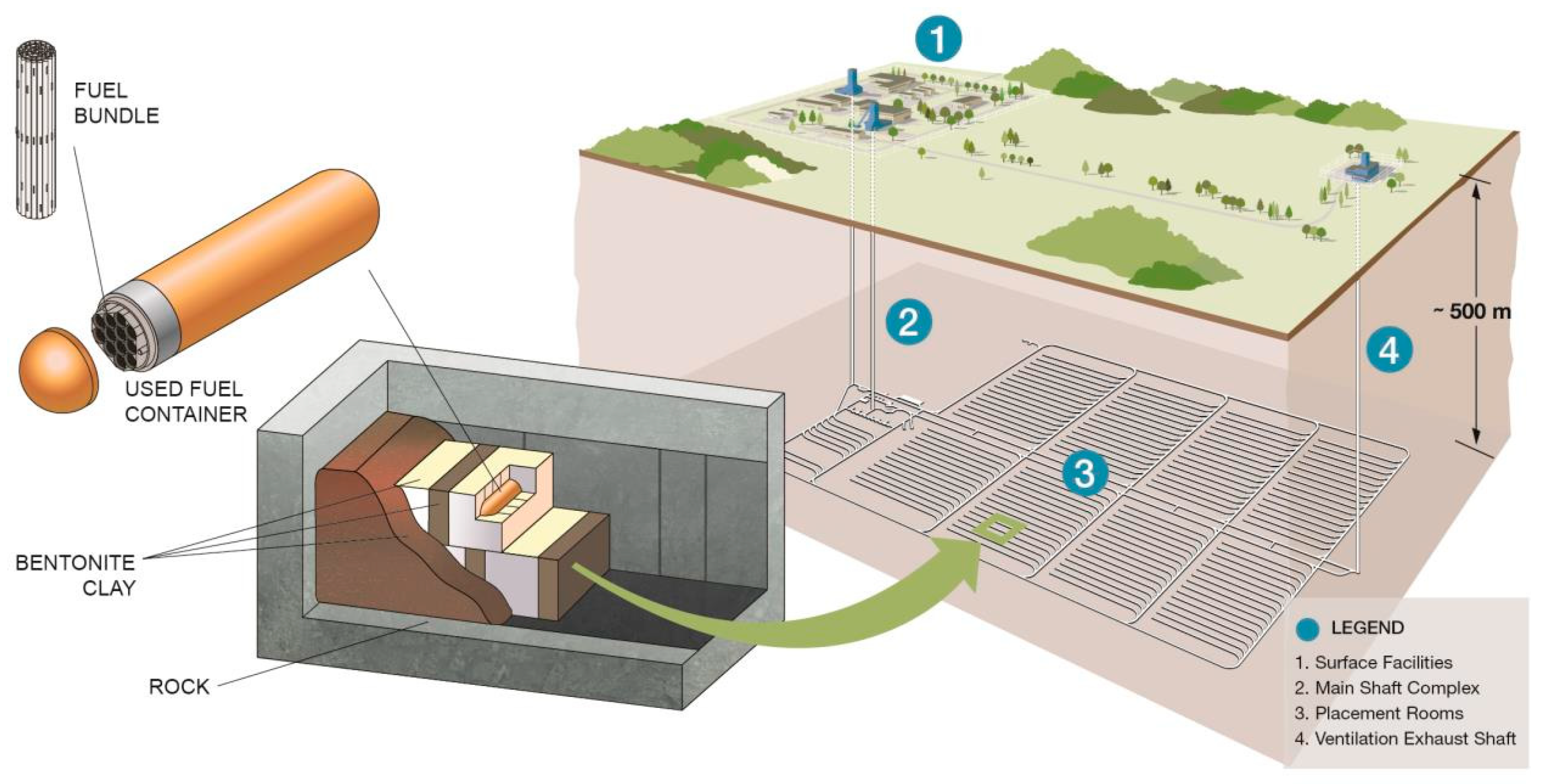

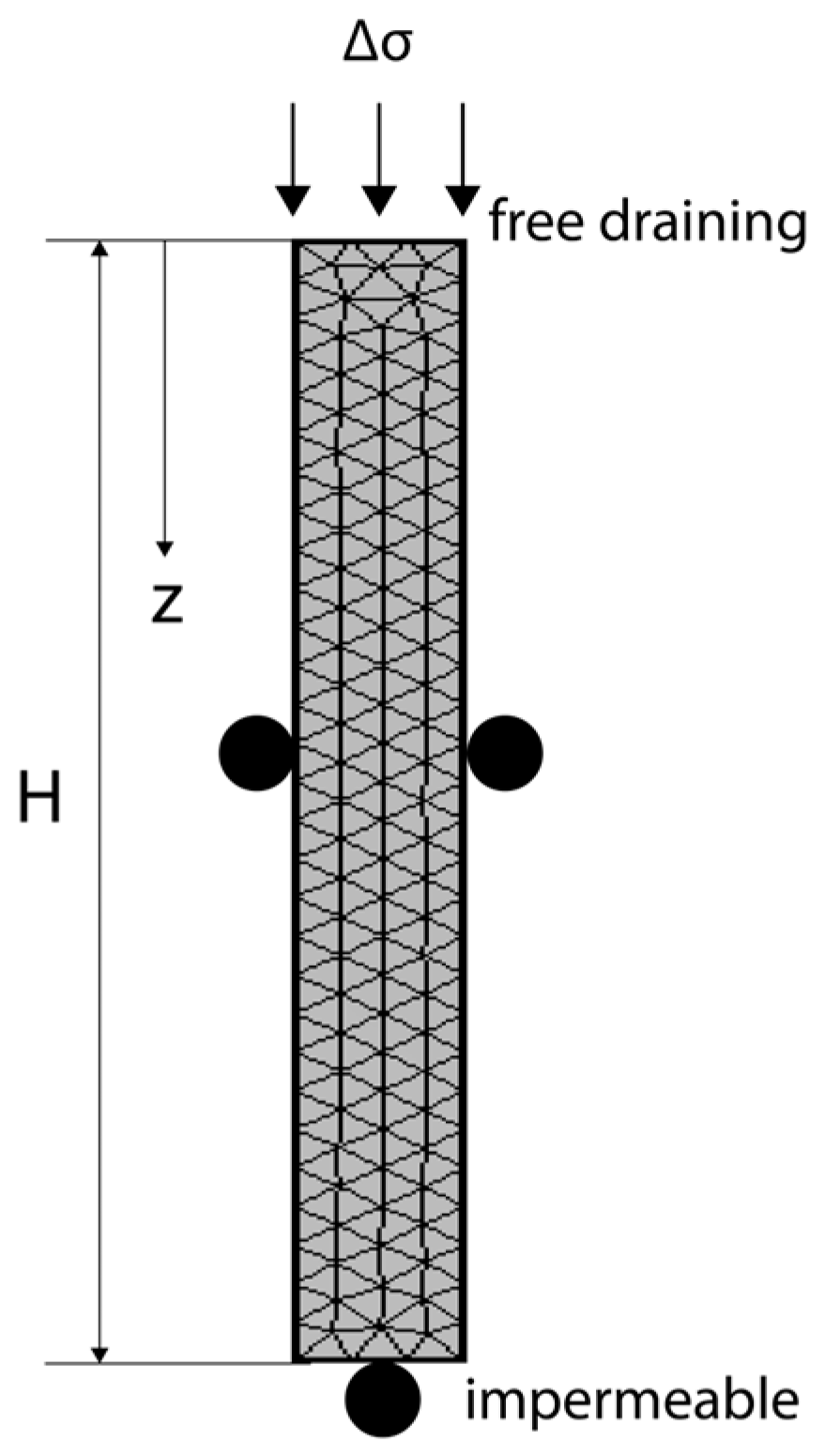
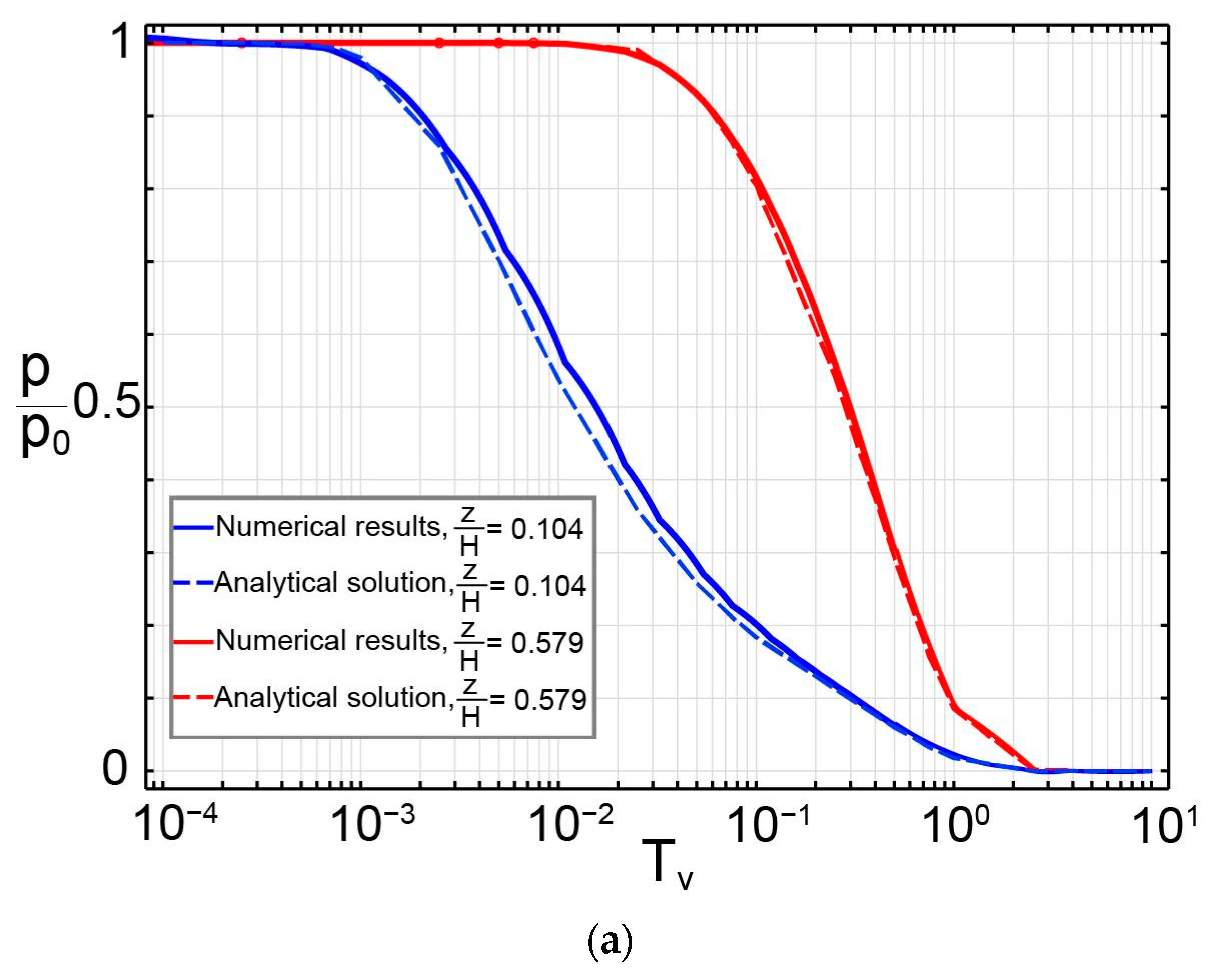




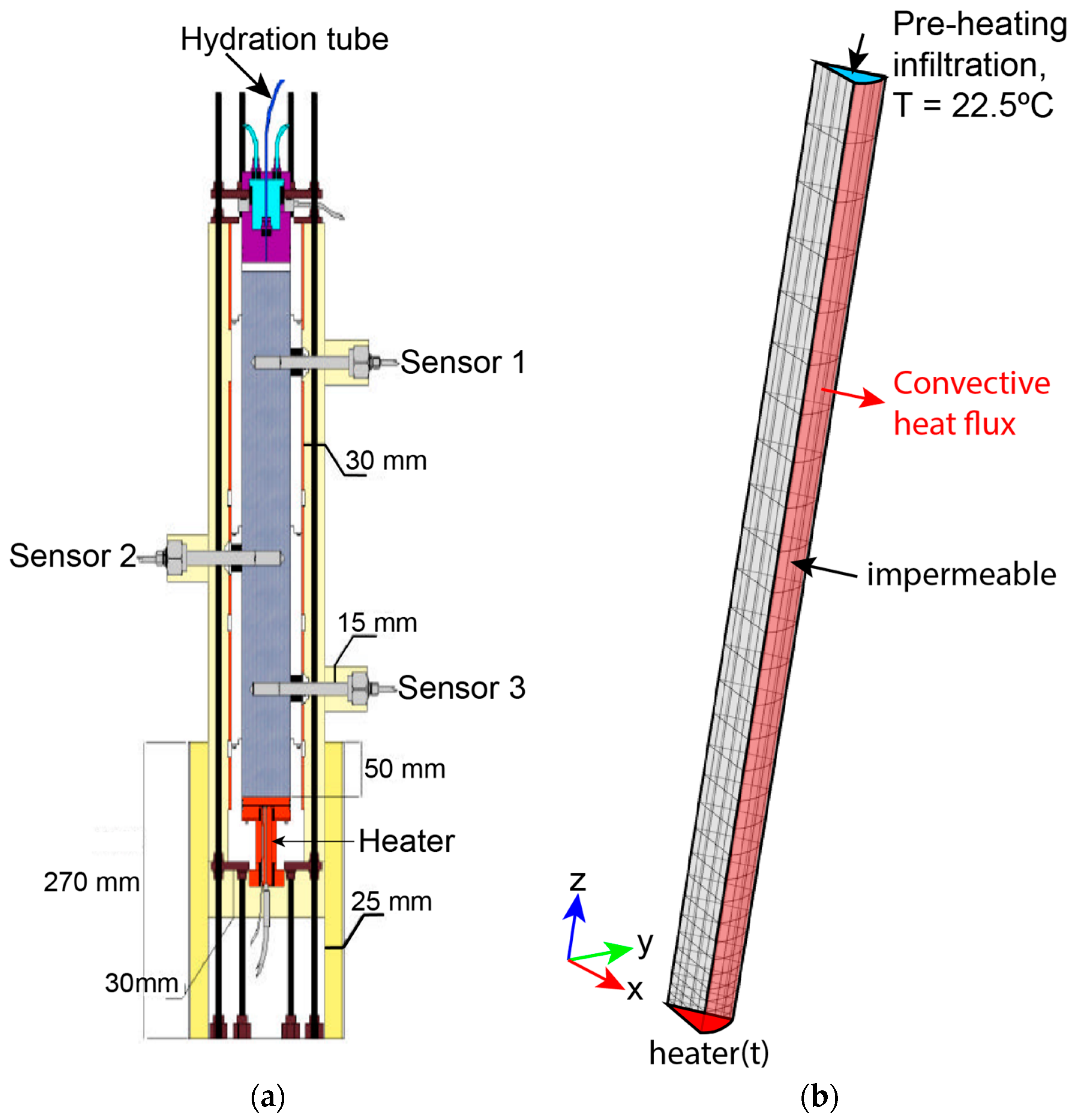
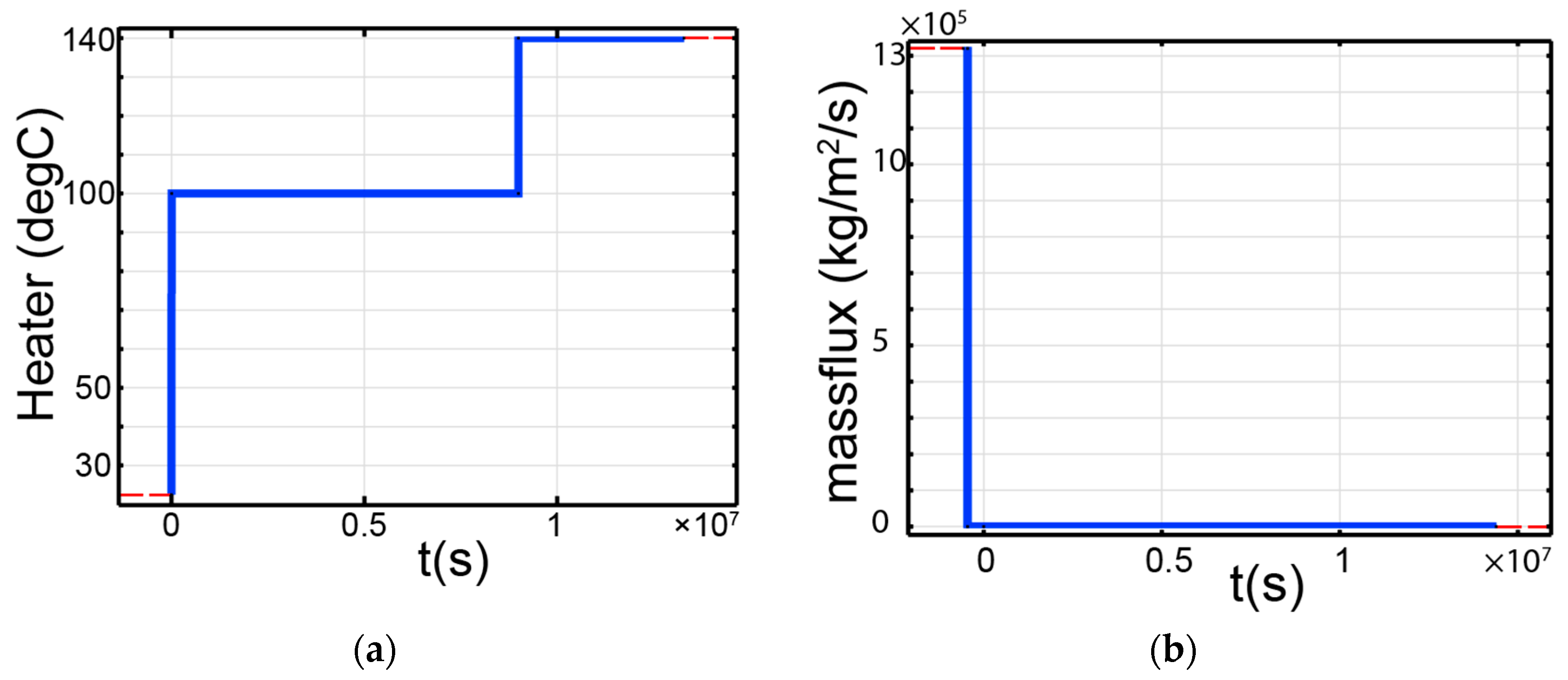
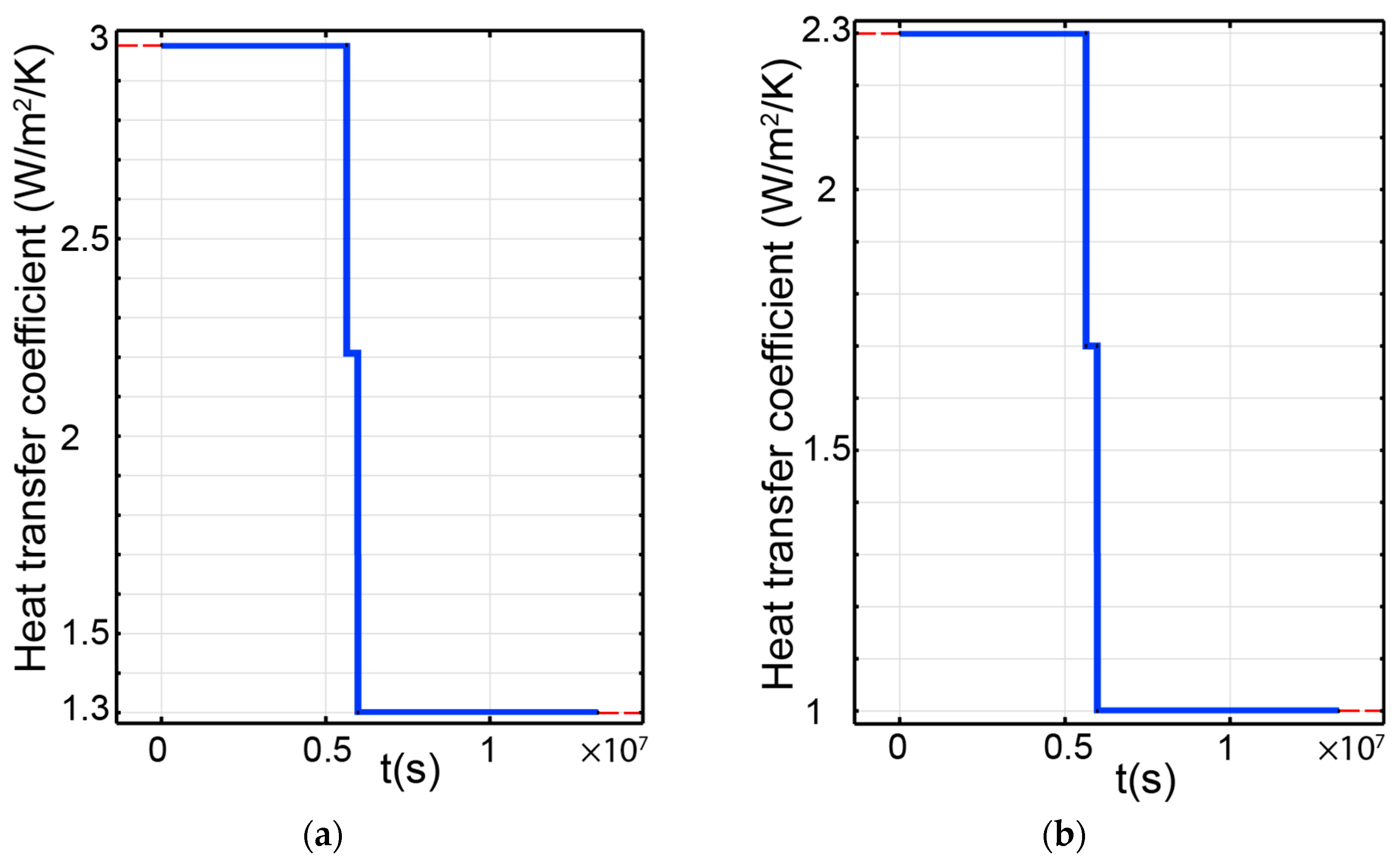



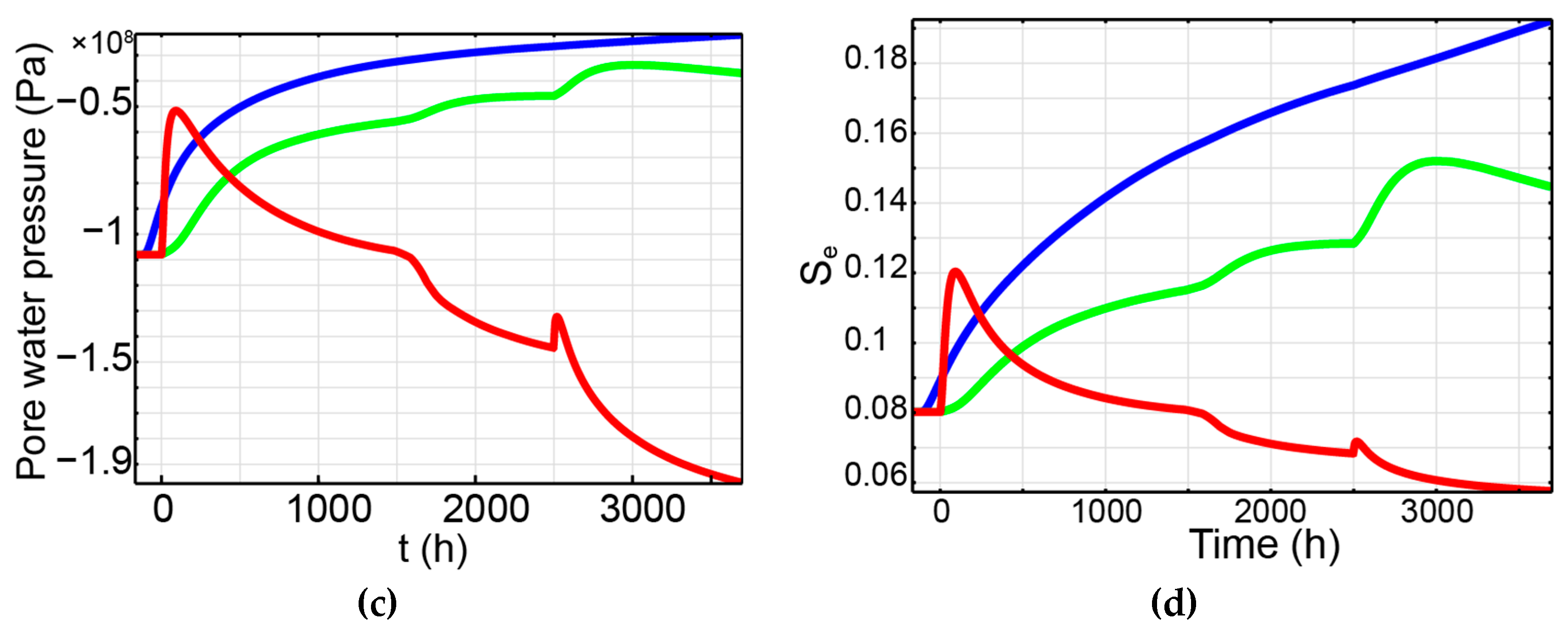

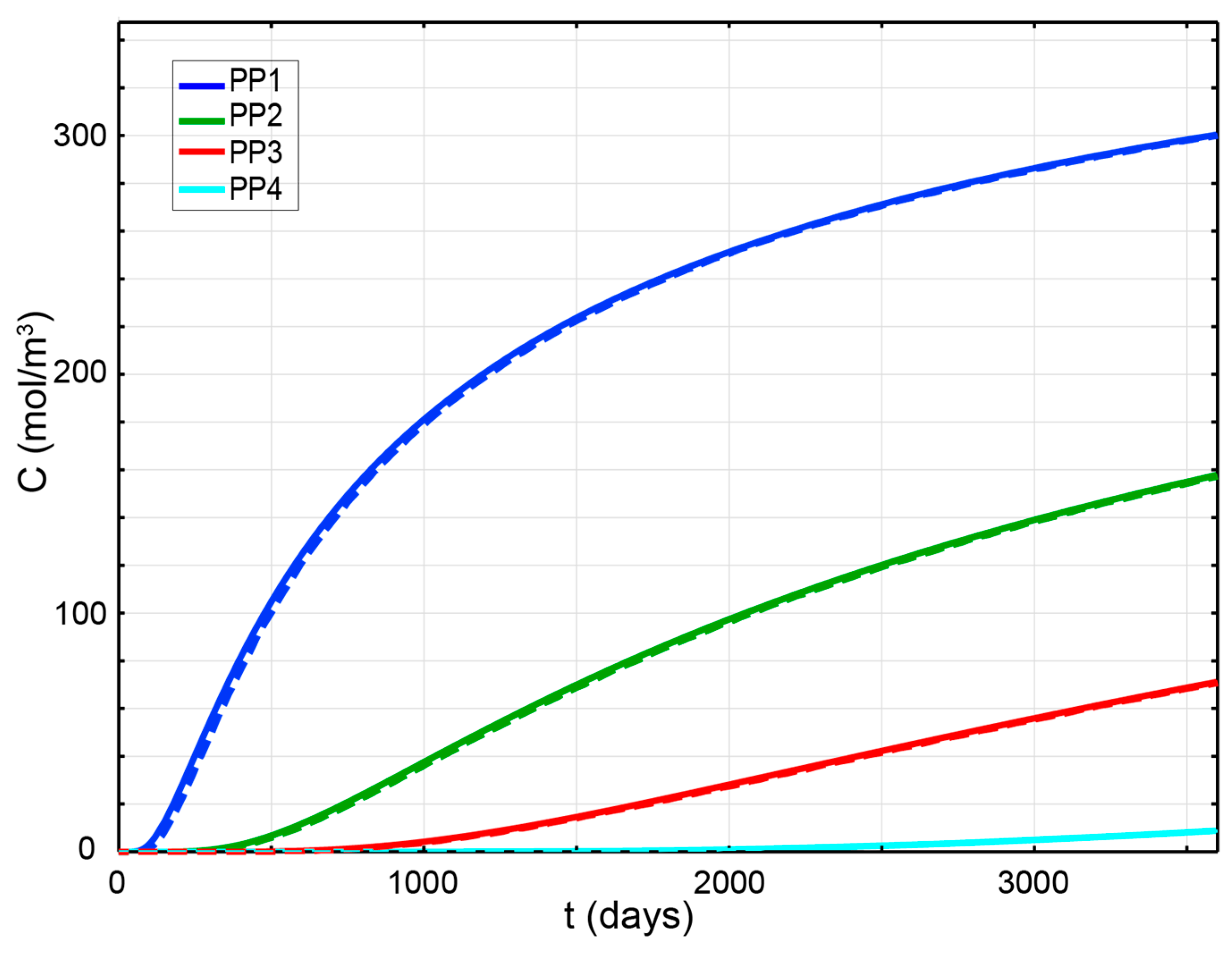
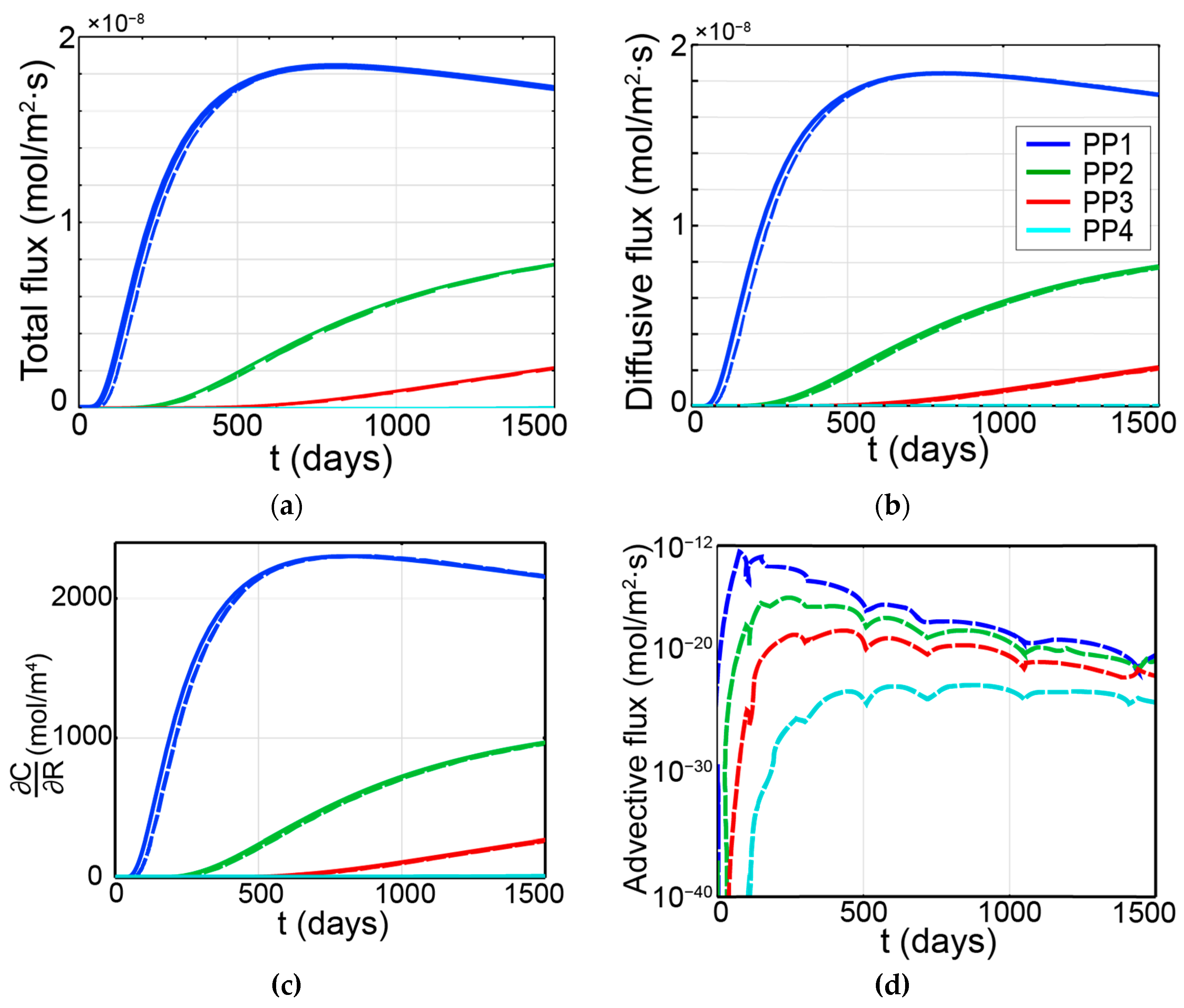

| Parameter | Value | Unit |
|---|---|---|
| Young’s modulus (E) | 5 × 109 | Pa |
| Poisson’s ratio (ν) | 0.3 | - |
| Biot’s coefficient (α) | 1 | - |
| Shear modulus (G) | E/(1 + ν)/2 | Pa |
| Point heat source (Q) | 300 | W |
| Porosity (n) | 0.16 | - |
| Density of water | 999.1 | kg/m3 |
| Density of solid | 2290 | kg/m3 |
| Equivalent density | kg/m3 | |
| Dynamic viscosity of water (μ) | 0.001 | Pa·s |
| Isobaric specific heat capacity of water (cw) | 4280 | J/kg/K |
| Isobaric specific heat capacity of solid (cs) | 917.654 | J/kg/K |
| Equivalent heat capacity (cp) | J/kg/K | |
| Volumetric thermal expansion coefficient of water | 4 × 10−4 | (1/K) |
| Volumetric thermal expansion coefficient of solid | 4.5 × 10−5 | (1/K) |
| Linear thermal expansion coefficient of solid | ||
| Intrinsic permeability (k) | 2 × 10−20 | m2 |
| Thermal conductivity of water (Kw) | 0.6 | W/m/K |
| Thermal conductivity of solid (Ks) | 1.838 | W/m/K |
| Equivalent thermal conductivity (K) | nKw + (1 − n)Ks | W/m/K |
| P1 (x1, y1, z1) | (1, 0, 0) | m |
| P2 (x2, y2, z2) | (0, 2, 0) | m |
| P3 (x3, y3, z3) | (0, 0, 3) | m |
| P4 (x4, y4, z4) | (0.35, 0.5, 0.6) | m |
| P5 (x5, y5, z5) | (1.3, 0.682, 0) | m |
| P6 (x6, y6, z6) | (30, 0, 0) | m |
| Parameter | Value | Unit |
|---|---|---|
| Young’s modulus | 13.5 × 109 [21] | Pa |
| Poisson’s ratio | 0.15 [21] | - |
| Biot’s coefficient | 0.8 [21] | |
| Porosity | 0.1 * | - |
| Density of water | 1000 | kg/m3 |
| Density of solid | 2550 | kg/m3 |
| Dynamic viscosity of water | 0.001 | Pa.s |
| Isobaric specific heat capacity of porous medium | 1096 | J/kg/K |
| Volumetric thermal expansion coefficient of porous medium | 1.5 × 10−5 | 1/K |
| Intrinsic permeability | 5 × 10−19 | m2 |
| Thermal conductivity | 3 * | W/m/K |
| Compressibility of fluid (χf) | 4 × 10−10 | 1/Pa |
| Compressibility of solid (χp) | 1 × 10−11 | 1/Pa |
| Fluid diffusion coefficient () | 8 × 10−12 * | m2/s |
Disclaimer/Publisher’s Note: The statements, opinions and data contained in all publications are solely those of the individual author(s) and contributor(s) and not of MDPI and/or the editor(s). MDPI and/or the editor(s) disclaim responsibility for any injury to people or property resulting from any ideas, methods, instructions or products referred to in the content. |
© 2023 by the authors. Licensee MDPI, Basel, Switzerland. This article is an open access article distributed under the terms and conditions of the Creative Commons Attribution (CC BY) license (https://creativecommons.org/licenses/by/4.0/).
Share and Cite
Vo, U.; Fall, M.; Sedano, J.Á.I.; Nguyen, T.S. A Multiphysics Model for the Near-Field Evolution of a Geological Repository of Radioactive Waste. Minerals 2023, 13, 1535. https://doi.org/10.3390/min13121535
Vo U, Fall M, Sedano JÁI, Nguyen TS. A Multiphysics Model for the Near-Field Evolution of a Geological Repository of Radioactive Waste. Minerals. 2023; 13(12):1535. https://doi.org/10.3390/min13121535
Chicago/Turabian StyleVo, Uy, Mamadou Fall, Julio Ángel Infante Sedano, and Thanh Son Nguyen. 2023. "A Multiphysics Model for the Near-Field Evolution of a Geological Repository of Radioactive Waste" Minerals 13, no. 12: 1535. https://doi.org/10.3390/min13121535





